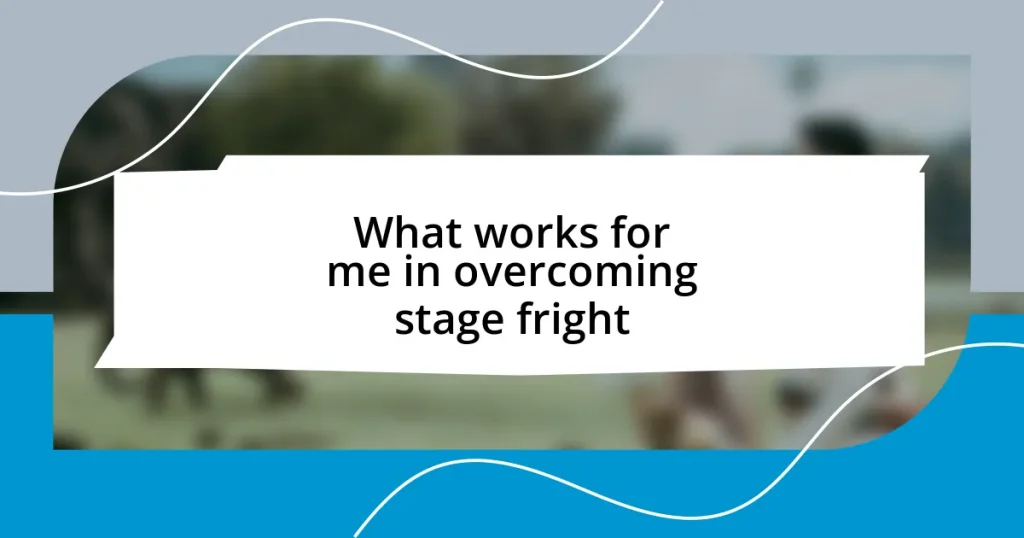Key takeaways:
- Mindfulness is about being present and observing thoughts and feelings without judgment, enhancing self-understanding.
- Integrating mindfulness improves focus, emotional regulation, and fosters deeper empathy in interactions.
- Daily mindfulness exercises, such as mindful walking and gratitude journaling, help cultivate presence and reduce stress.
- Creating a mindful work environment involves optimizing physical space, minimizing distractions, and encouraging communal mindfulness practices.

Understanding mindfulness practice
Mindfulness practice is about being present and fully engaging with the current moment. I remember a time when I rushed through my morning coffee, hardly tasting it, when I suddenly realized that savoring that experience could completely shift my day. Have you ever paused to appreciate the warmth of your cup or the aroma of the coffee?
At its core, mindfulness is a technique that encourages us to observe our thoughts and feelings without judgment. One evening, while meditating, I felt a wave of anxiety sweep over me, but instead of pushing it away, I simply acknowledged it. It felt liberating to sit with that discomfort without needing to change it. Isn’t it fascinating how embracing our feelings can actually help us understand ourselves better?
When I integrate mindfulness into my daily activities—like taking a mindful walk—each step feels more intentional and connected. I often find myself noticing the small details around me, like the rustle of leaves or the laughter of children. It’s remarkable how these moments can ground us, isn’t it? Mindfulness is more than a practice; it’s a way of living that enriches our everyday experiences.

Benefits of mindfulness integration
The integration of mindfulness into my practice brings a wealth of benefits that I’ve experienced firsthand. One significant advantage is enhanced focus. When I consciously bring my awareness to the task at hand, distractions fade, and I find myself immersed in my work. Have you ever noticed how multitasking can dilute your effectiveness? By practicing mindfulness, I’ve learned to concentrate better, which boosts my productivity and makes my work feel more fulfilling.
Another benefit I’ve encountered is improved emotional regulation. During challenging moments, like a heated discussion with a colleague, I remind myself to pause and breathe. This simple act of mindfulness gives me the space to respond rather than react. Isn’t it empowering to navigate your emotions with such clarity? I’ve realized that taking a moment to process my feelings not only improves my interactions but also fosters a more positive work environment.
Lastly, integrating mindfulness cultivates a deeper sense of empathy. I’ve found that being present allows me to truly listen to others without formulating my response while they’re still talking. One time, I paused before replying to a friend’s story and simply reflected on her feelings. This small shift led to a more profound conversation—one where she felt truly heard. The warmth that came from that moment lingered between us, underscoring the power of mindful engagement.
| Benefit | Personal Insight |
|---|---|
| Enhanced Focus | Mindfulness helps me stay present, improving my concentration and overall productivity. |
| Improved Emotional Regulation | Pausing to breathe during stressful moments helps me respond thoughtfully rather than impulsively. |
| Deeper Empathy | Being fully present allows me to listen to others and foster meaningful connections. |

Daily mindfulness exercises
Engaging in daily mindfulness exercises has become a cornerstone of my routine, allowing me to cultivate a more profound sense of presence. One favorite practice is dedicating five minutes each morning to focused breathing. As I inhale deeply, I feel my chest rise and my mind slowly quiet; it’s like pressing a reset button for the day. Have you ever noticed how even a brief moment of intention can alter your outlook?
Here are some exercises I find particularly beneficial:
- Mindful Walking: I take a stroll in the park, paying attention to each step and the sensations beneath my feet.
- Gratitude Journaling: Writing down three things I’m grateful for each day keeps me anchored in positivity.
- Body Scan Meditation: I lay quietly and mentally scan my body from head to toe, releasing tension as I go.
- Mindful Eating: One meal per day, I intentionally savor each bite, enjoying the textures and flavors without distractions.
- Check-in Moments: I set reminders on my phone to pause for a moment, breathe, and take stock of my thoughts and feelings.
These exercises slice through the noise of my busy life, allowing me moments of clarity and calm. Just the other day, while savoring a delicious piece of dark chocolate during my mindful eating session, I felt every nuance of flavor unfold, bringing a simple pleasure that I usually rush through. It’s in these little practices that I find balance and a renewed appreciation for the present.

Mindfulness techniques for stress relief
One technique I turn to when stress creeps in is the “5-4-3-2-1” grounding exercise. Essentially, it’s about engaging my senses to anchor myself in the present. I look around and identify five things I can see, four things I can touch, three things I can hear, two things I can smell, and one thing I can taste. I remember a time when a chaotic day at work left me feeling overwhelmed; this exercise helped ground me back into the moment. Have you ever felt the tension melt away when you truly focus on your surroundings?
Another method that truly resonates with me is mindful visualization. I often picture myself in a serene place—like a tranquil beach with gentle waves lapping at my feet. I take a few minutes to immerse myself in that mental image, allowing the sounds and sensations to wash over me. This has been incredibly powerful during stressful weeks; I can almost hear the ocean and feel the warmth of the sun on my skin. It’s striking how a vivid mental escape can shift my mood and rekindle my sense of calm.
Finally, I’ve found benefits in practicing “mindful pausing” throughout my day. When I feel a wave of stress, I take a brief moment to pause, breathe deeply, and acknowledge my feelings. Just yesterday, while juggling several projects, I paused for a few seconds to ground myself. This simple act allowed me to return to my tasks with renewed clarity instead of spiraling into overwhelm. How often do we forget that a moment of stillness can lead to greater productivity? By incorporating these techniques into my routine, I’ve learned that stress relief doesn’t have to be complicated—it can be as simple as taking a breath.

Creating a mindful work environment
Creating a mindful work environment starts with the physical space itself. I’ve learned that the layout of my workspace can greatly influence my focus and well-being. When I added some plants to my desk, I didn’t just brighten the area; I felt a noticeable reduction in stress levels. Have you ever noticed how a touch of nature can instantly uplift your mood?
In addition to aesthetics, I prioritize quiet zones for deep work. I often designate specific times to turn off notifications and immerse myself in tasks without distraction. This practice has transformed my productivity. It’s almost magical how my mind can switch gears and dive deeply into a project when I’m not constantly interrupted. Can you relate to the frustration of trying to concentrate amidst a flurry of pings and alerts?
Moreover, fostering a culture of mindfulness among my colleagues has been incredibly rewarding. We occasionally hold mindfulness breaks during meetings, where we take a few moments to breathe and connect. The shared experience creates a sense of community and support. Once, after a particularly intense brainstorming session, these breathing exercises helped us all return to the table with renewed energy and creativity. Isn’t it remarkable how a few shared breaths can change the energy in a room?

Measuring progress in mindfulness
Tracking progress in mindfulness can be an enlightening journey. Personally, I find it incredibly helpful to maintain a daily journal where I can reflect on my experiences. Noticing small shifts—like increased awareness during stressful moments—has made a significant difference in my practice. Have you ever paused to reflect on how far you’ve come?
I also use guided mindfulness apps to evaluate my consistency and improvement. Each time I complete a session, I’m not just checking off a box; I’m engaging in a tangible way with my progress. I remember feeling so motivated after completing my first 30-day challenge that I decided to celebrate that milestone— I treated myself to a cozy evening at home, enhancing both my mindfulness and my sense of self-care. Isn’t it rewarding to treat ourselves for our achievements?
Another approach is to set specific intentions and revisit them regularly. For instance, I started a mindfulness challenge with a goal to pause mid-afternoon for a few deep breaths. Reflecting on how that simple practice helped me stay focused and energized throughout the day showed me that mindfulness is a journey, not a destination. How have you measured your own Mindfulness progress?

Overcoming challenges in mindfulness practice
Overcoming challenges in mindfulness practice can often feel like an uphill battle, yet I’ve found that acknowledging those difficulties is the first step. There was a time when my mind seemed perpetually active, racing through thoughts about what I needed to do next. It was frustrating, but I came to realize that even this mental chatter was a part of my mindfulness journey. Have you ever thought about how distractions can serve as teachers in your practice?
One specific challenge I faced was time management. Initially, I struggled to carve out space in my busy schedule for mindfulness. But then I started using small pockets of time—like while waiting in line or during my commute—to practice mindfulness. This shift was enlightening; I discovered that even a minute of focused breathing or a quick scan of my sensations could ground me. Have you tried integrating mindfulness into brief moments throughout your day?
Another obstacle was self-judgment. I often criticized myself for not being “good” at mindfulness, which created a barrier to truly engaging with the practice. When I finally allowed myself to be imperfect, I noticed profound changes. Accepting that mindfulness is not about achieving a perfect state of calm, but rather about observing my thoughts and feelings without judgment, liberated me. Has embracing imperfection ever opened new doors for you in your mindfulness practice?
















